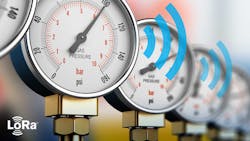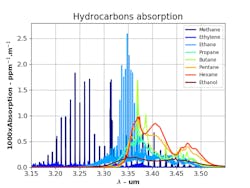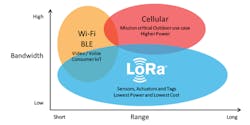Low-Power, Long-Range Sensors Detect Gas Leaks
What you’ll learn:
- Why low-power, long-distance IoT sensors are optimal in detecting gas leaks.
- How does increasing sensor reliability through no-drift output eliminate the need for recalibration?
- How open networks can future-proof connectivity.
Detecting natural gas leaks in any situation is extremely important, as the potential for catastrophic damage and loss of life is significant. This means monitoring known leaks in real-time before fixing them, including in residential networks, at the point of entry of the gas line inside homes and buildings, distribution networks, at compression stations or storage facilities, and industrial networks.
The latest wireless solutions are empowering leak detection, thanks to low-power long-distance IoT sensors that are now well-suited to detect gas leaks. These advanced devices have an extended longevity with reliable and accurate output over time due to advances in the core technologies involved. In addition, wireless cloud-enabled open networks can provide future-proof connectivity for the foreseeable future.
One example of such an advanced solution is the eLichens avolta-CH4 gas leak detector, which can remotely identify leaks on natural gas infrastructures. Such devices are used primarily by gas utility companies, as well as gas leak survey and maintenance companies. This article will cover the configuration and system integration of the avolta-CH4 gas leak detector.
Addressing the Challenge
Sensing dangerous gases presents multiple challenges. Among them, ensuring reliability in detecting the right substance, preventing false alarms, and ensuring actual leaks are most recognized. Gas leaks are destructive, and the market is a very stringent one, where false alarms can cost a lot—and no alarm can cost even more—so reliability is paramount.
Historically, the typical leak detector is installed in the basement of a building. This is problematic as other chemicals also may be stored there, or it’s where mold can grow and generate volatile hydrocarbons. Both scenarios can trigger false alarms.
In the case of the avolta-CH4 gas leak detector, the sensor embedded inside is highly selective to methane, which increases accuracy. It also can be equipped with other versions of the sensor; thus, it can detect many other gases like butane, propane, refrigerant gases, or even CO2.
At the heart of the device is the Foxberry CH4NB sensor, designed specifically for this application. It has a no-drift output as well as an ultra-high selectivity and sensitivity to methane. This NDIR sensor has a specific proprietary optical filter, able to selectively target the CH4 wavelengths.
Since it’s sensitive to a narrow range of gases, the sensor is referred to as a “CH4 Narrow Band (CH4NB)” device and is presented as the first one of its kind (Fig. 1). It has been designed according to UL1484 and EN50194 standards for the highest levels of reliability.
Legacy gas sensors usually need to be recalibrated every one to two years, or the best ones on the market can barely reach five years. The avolta-CH4 gas leak detector doesn’t require any recalibration over its entire lifetime of more than 10 years.
This sensor was enabled by a partnership with Semtech, which was involved from the beginning of the project, especially on the technical side. The detector was eLichens’ first integration with Semtech’s LoRa devices, so it relied heavily on Semtech for recommendations on things like module selection and design choices. The company now has two products utilizing LoRa in its catalog and more are in the works.
Semtech’s long-range, low-power sensor technology leverages the industry expertise at eLichens to make possible the development of this battery-powered IoT product with more than 10 years of autonomy. It needs no maintenance and is easy to install, even in large-scale deployments.
Working Wirelessly
The sensor runs on the LoRaWAN standard—a low-power, wide-area network (LPWAN) protocol (Fig. 2). By design, the LoRaWAN standard is able to wirelessly connect and provide information in an efficient, low-power and sustainable manner. It’s based on what’s called a “chirp spread spectrum” in order to maintain low power and simultaneously increase the communication range.
Chirp spread spectrum has been used in military and space communication for decades, but LoRa is the first low-cost implementation for commercial usage. For the avolta gas sensor, LoRa proved to be an excellent fit due to its low power consumption, long communication range, and high-security characteristics. The LoRaWAN standard also allows for non-proprietary characteristics, which opens a wide range of applications.
The next iteration of the avolta gas detector will have a 20-year battery lifetime version, to reach the same lifetime as smart meters. Moreover, the company is working on integrating the device into a larger ecosystem (shut-off valve, additional sensors, and more), to design a broader gas safety solution for its customers. In parallel, eLichens is working on specific versions of the detector, including an ATEX/IECEx version, to address new markets.
The cost of a gas incident in a residential area will always be more than the cost of installing one sensor per building. In the world of IoT, there are always economies of scale, especially when open networks like LoRaWAN are installed. Once such a network is in place, it opens the possibility to connect additional sensors, hence opening the path to more safety and more services.
About the Author
Rémi Demerlé
Director, Developer Ecosystem, Semtech, and Chairman of Smart Utilities Workgroup, LoRa Alliance
Rémi Demerlé is director, developer ecosystem at Semtech and the chairman of the smart utilities workgroup for the LoRa Alliance. Rémi helps drive the promotion of LoRa devices and the LoRaWAN standard to sustain its development in the utility vertical, and leads the utilities workgroup of the LoRa Alliance.
Prior to joining Semtech, Mr. Demerlé held various business development, executive, and consulting positions for Telenor, Renesas, Sierra Wireless, Hewlett Packard, and Wavestone, accumulating experience leading marketing and business development initiatives for the Internet of Things in fleet logistics, smart metering, and car telematics applications.
Mr. Demerlé has a Master of Science degree in Electronics, Networks and Telecommunications from the National Institute of Polytechnique from Grenoble (INPG) in France.


